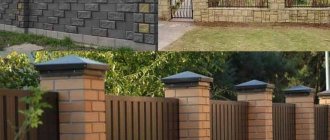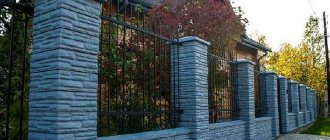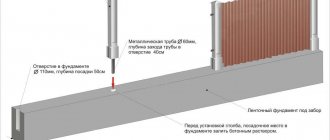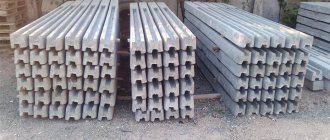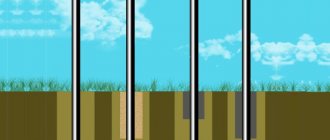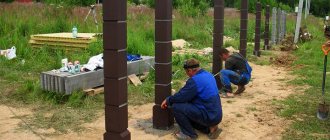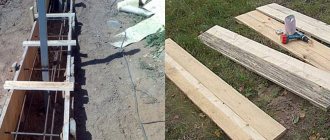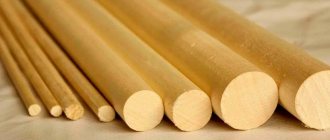Options for recessing fence posts
In order to choose the right support posts for a fence, you must initially know what kind of load we are talking about and what functions these posts should perform. When constructing such structures, several options for pillars can be used. Pillars can be made of wood, metal, asbestos cement, concrete or brick.
Choosing a tree
Considering that good quality wood is now quite expensive, and even if high-quality tree species are used in the manufacture of wooden poles, such structures will not last you very long.
The process of deepening wooden fence posts
Such fence supports are most often used as a decorative element. Although, with proper treatment, for example, in a solution of copper sulfate or with systematic painting, wooden supports can serve you for many decades. That is why, in most cases, such poles are used when you need to build a low hedge, temporary fence or front garden.
Criterias of choice
Factors on which the choice of material and pole design depends:
- Purpose. Various solutions are being developed for options when it is necessary to build an economical fence between neighboring areas, a respectable fence as part of the entrance group, or a decorative fence to mark the boundaries of zones.
Type of section filling. The load on the pillars varies significantly, whether it is a light, breathable picket fence, solid corrugated board or heavy brick.
Required fence height. It is selected based on the recommendations of urban planning norms or SNT rules. In most cases, it is limited to 1.5-2.2 m.
Soil type. Sandy, rocky or waterlogged soils require different approaches. Possibility of DIY installation. Not all types of poles are suitable for self-installation. In particular, driven piles are mounted only with a special pile-driving mechanism.
The calculation is carried out based on the wind load, type of filling and bearing capacity of the soil. In accordance with the tasks set and the results obtained, the issue of the design of the pillar and the material for its manufacture is decided.
A budget option
A budget method is also possible when constructing a fence and selecting supports for it. Then your choice may be in favor of asbestos cement products. Reliability and low cost are the two qualities that speak in favor of asbestos-cement pipes.
Unlike wooden structures, such structures will serve you for decades. But there are still disadvantages in this option. First of all, it is very difficult to select fasteners for such pipes. This option uses clamps and clamps.
If you do not install a special canopy over such a pillar in time, then it can easily turn into a well; water is collected in the middle of such a well and when it freezes, the water turns into ice, and the pillar can break.
Instead of attaching a canopy, you can concrete the inner cavity of the post, but such an installation will cost much more.
Hole parameters
Chernozem-sandy loam soil is less dense. Heaving (as a result of prolonged frosts) also makes adjustments to the depth and diameter of the hole. In such soil, the depth of the underground part of the pillar is at least a meter. Many owners of country houses, replacing an old mesh fence with a new one (made of corrugated pipes and roofing sheets), bury the posts to a level of 1.4 meters or more. Loamy (or clayey) as well as rocky (containing smooth stones or rock fragments) soil eliminates the need to bury the pillars to a depth of more than a meter. Common depth is 0.8-0.9 m.
A hole diameter greater than half a meter is not practical for fence sections. The fence does not belong to a permanent type of structure: it is only affected by its weight, hundreds of times less than the weight of a small country house, and possible windage during a hurricane (profiled sheet flooring resists the wind). The gate, combined with a wicket, allows you to slightly exceed the diameter of the hole, however, the user knows that the deeper and wider the hole under the post, the more concrete will be needed. The larger diameter, length and weight of the concrete “ingot” will make it possible to hold the pillar for decades, preventing it from tilting even a degree.
The height of the above-ground part of the post for the same fence is no more than 2 m. It makes sense to install a higher fence if the object is not a dacha or a country house, but a protected building, for example, a point or branch of a state office, a university, a hospital, a military unit, etc. d. A fence that is too low threatens a constant violation of the access regime adopted by the checkpoint. The distance between the centers of two adjacent holes (the location of the posts) is chosen so that the fence does not squint or fall, for example, due to frequent and strong winds in the area. For example, for pillars where a square corrugated pipe with a cross-section of 50*50 mm is used, and a rectangular pipe 40*20 is used as horizontal crossbars, the optimal distance between two adjacent supports is no more than 2 m.
Reliable supports for fencing
Deepening concrete support elements of the fence
If we are talking about supports made of concrete or brick, then such structures are used when installing large and massive fences. Brick supports can also be used as decoration for a fence made of any material.
Concrete supports will be the right choice for those who want to save their finances, but at the same time spend their time and put more effort into their manufacture.
When manufacturing and installing such poles, you may encounter a number of difficulties, for example, you cannot install such a pole alone, there may be problems during transportation due to the large weight of the products, but on the other hand, such structures are inexpensive to manufacture, durable and convenient in that they can be manufactured possible right on the spot.
Brick pillars are perhaps the most expensive type of all the above structures. They are usually chosen by those who want to show off. It must be taken into account that a strong and reliable foundation must be laid under such a brick pillar.
Why do fences fall?
Insufficient laying depth is not the only factor leading to damage to the fence. Often the reasons are violations of installation technology, in which a normally buried pole becomes loose, tilts and may even fall. This:
- poor-quality concreting without compaction;
- backfill with voids;
- absence of an anchor on the heel of the post in loose or highly heaving soils, high groundwater level;
- spans of different lengths, due to which the loads are distributed unevenly;
- erosion of the base under the column by water flowing from the site;
- weak reinforcement;
- poor quality protection against corrosion of metal structures;
- precipitation entering the rack cavity, causing rapid corrosion or rupture.
Deformation or destruction of the fence can be caused by a support cross-section that is too small and does not correspond to the current loads. For metal profile pipes, the optimal dimensions are 50x50 mm or 60x60 mm with a wall thickness of at least 2 mm.
Popular supports
Options for deepening metal fence supports
Pillars made of metal pipes are considered a hit. Such structures are reliable, durable, easy to use, and technologically advanced. Any structure can be welded to such pillars. They can serve their owner for decades.
So, the material for your structures has been chosen. Now the main thing is to make correct and competent calculations. It is important to choose the right place on the territory and calculate the number of poles that you will make.
Useful aspects
If you like a fence and gate made of corrugated board, the advantages of such a choice will be more than obvious.
- A fence made of corrugated sheets allows you to guarantee protection of your summer cottage from the appearance of uninvited guests and unwanted small and large animals. Due to its profiling properties, this design is quite economical both during construction and during further operation and is very popular and in demand in modern life.
- Excellent high-quality sheet steel allows you to provide any size of your personal plot and build a fence of any desired width and height. Moreover, it will not have even tiny cracks and other unwanted holes.
- The installation of a durable fence made of corrugated sheets is determined by the speed of its construction, starting from scratch. This is perhaps one of the most important indicators influencing the choice of a particular material for construction. It will take only 2-3 days to completely build such a high-quality and durable structure.
- Corrugated sheeting harmonizes perfectly and is combined with any other materials, for example, with a variety of brick columns.
- Scientists also separately note that a sufficiently high fence made of corrugated sheets can muffle any street noise effects that interfere with outdoor recreation by about 70%. In other words, excellent high sound insulation is created, giving the home cozy comfort and reliable protection from the outside world. In such a quiet garden it will be very pleasant to sit on warm summer days, enjoying the murmur of a small fountain near the picturesque veranda and admiring the evening sunset.
- Such extremely weather-resistant material is not afraid of strong winds, heavy rains, or scorching sun.
- In addition, installation of a fence made of corrugated sheets is possible on an individual order, absolutely for every taste.
- It is also important that the construction of such a structure is quite cheap. It's safe to say that price determines quality.
- Many choose this type of fencing due to its increased strength, resistance to mechanical stress and, as a result, long service life.
- Easy to use.
- Thanks to the assembly features, replacement of individual sections is made with extreme ease, despite the large size.
- A metal fence made of corrugated sheets guarantees very easy maintenance, which consists of maintaining the frequency using a regular garden hose.
It is enough to water it just once a week, and it will again begin to shine and sparkle in the sun.
- The service life is quite long by today's standards and is about 30–50 years, which speaks for itself.
Before purchasing corrugated sheeting, given the size of your suburban garden plot, it is advisable to visit a number of construction stores. At the same time, take a very careful look at the proposed choice of such material in order to have a general idea of it, and from all the rich variety, choose the best option for yourself, depending on your taste preferences and financial capabilities.
We deepen the supporting elements
If all calculations are performed correctly, then distortions and collapses will not threaten your structures:
- When calculating the number of pillars, you need to take into account the size of the sections of your product and the length of the entire structure.
- A very important question is that you immediately understand what kind of soil you are going to drive the supports into. Here we will talk about the quality and chemical composition of the soil itself in which you are going to dig your products.
- In order for the hole to be dug correctly, you need to take into account all the features of the material from which the supporting elements are made.
Concreting is perhaps the most versatile method when installing pillars.
This method consists of digging a special hole under the support - a hole. In order to make the task easier, such holes are dug using a drill. If you need to increase the efficiency of drilling, then water is poured into such a hole for approximately 10-15 minutes. This is done to make the earth more pliable and soft.
The depth of the pit itself will depend on the height of the entire structure. For example, if the height of the support does not exceed one and a half meters, then it is enough to dig a hole whose depth will be 0.5 meters.
If the pillars exceed the height of one and a half meters, then deeper holes are dug from 0.8 to 1.2 meters. There is even a corresponding proportion that the depth of the pit should correspond to 1/3 of the heights of the structure you choose.
If you decide to bury pillars on soils in which there is no heaving, then you can, in general, do without concreting and use the drilling method. The only caveat is that the diameter of the drill must match the diameter of the post itself. Then the support will fit into the hole very tightly and you can do without concrete.
Installation on subsiding soils
These include clayey and other soils with low density (loess). When a load appears and is moistened, such soil gives additional subsidence, the magnitude of which depends on the force of the impact. Therefore, to install a lightweight fence made of mesh or corrugated sheets, you can use the same methods - driving and backfilling. The immersion depth is calculated according to the following rule: the underground part of the support should be 1/3 of the entire length.
To prevent subsidence of heavier fences, it is necessary to distribute the weight over a larger area. To do this, the pits are made wider, and steel sheets are welded to the bottom of the racks before installation. Then the method of completely concreting the pillars is used to prevent lateral swaying by the wind.
When installing a stone fence with heavy wrought iron gates, you need to rely on horizons that are not subject to subsidence. The depth to which a reinforced concrete foundation will have to be buried depends on the region of residence; it can range from 1 to 2 m. To reduce the cost of constructing such a foundation, there are 2 ways:
- arrange a shallow foundation of a strip type together with columnar foundations;
- use screw piles that go into stable soil layers.
Piles that have a fulcrum are not afraid of either vertical or lateral impacts. To distribute the weight of the fence, their heads are combined by one concrete slab - a grillage, from which the brickwork begins.
For problem soil
Concreting the supports of a fencing structure
But what should those who have problematic soil, so-called in common parlance, “complex” soil, with a high level of groundwater, do? Then the process of digging holes will look a little different.
Initially, you need to take into account that the deepening of such a structure should occur below the freezing level of the soil itself. It will not be possible to bury and equip pillars with simple concreting here, so deepening will be more labor-intensive and, accordingly, costly.
If you invest good money in the purchase of concrete, spend a lot of your time and labor, but do not arrange the holes correctly, then, unfortunately, this structure will not last long. Therefore, in this option, the bottom of the pit must be filled with crushed stone or sand.
The layer of crushed stone in such a hole is about 20 cm, and then the following actions follow:
- The product is installed in a pit;
- Using building levels, plumb lines, it is leveled vertically and carefully compacted.
- A layer of crushed stone is added to the remaining space again, which is not filled to the ground level by about 10 - 15 cm.
- Well, the remaining space of the pit can already be concreted with fresh mortar, layer by layer.
In its own way, crushed stone plays the role of drainage for such a support, and will be a reliable, protective and softening element from the effects of precipitation and frost.
What factors does depth depend on?
Remember that the load that will be placed on the pillars can also be different:
Static vertical. The force here will act from top to bottom and directly depends on how much weight the structure has.
Each pillar will have to withstand the load of two adjacent side spans, and, of course, its own weight.
Dynamic. In this case, the impact of wind force on the fence is implied; accordingly, the load will be at different angles.
How exactly the load should be calculated depends on the original material of the fence. After all, if you install a brick or stone fence, then clearly the static load will be much greater than the dynamic one.
But if you want to install a fence made of corrugated sheets, plastic or thin boards, then in this case you cannot ignore the load from the wind, since in strong gusts it can be quite significant.
Roughly speaking, the depth to bury fence tables depends on several factors, here's what you'll need to consider:
- Total weight of the structure;
- Properties of the soil of the site itself;
- Windage of the structure;
- Distance between supports.
Also keep in mind that calculating the load yourself can be quite problematic.
Video lesson on the topic:
Therefore, if you doubt your abilities, you better seek help from a professional who will calculate everything properly.
Another option
The process of driving fence supports to the required depth
There is another way to drive in pillars, which does not require digging holes, and you do not have to concrete them. Using this method is effective if the soil composition on your territory does not have layers of compacted rocks.
Then driving in ordinary and low pillars, one and a half meters high, can be done using a sledgehammer. If your structure exceeds two meters in height, then a structure such as a “grandmother” is used. This product is made from a pipe about a meter long.
In such a pipe, one end is approximately 20 kg heavier than the other. When using such a “grandmother”, the accuracy of the blow should be taken into account. Performing this installation technique requires precision, and the blows are made strictly along the axis.
Difficulty may arise when lifting such a product. To improve the work, long handles are welded to the headstock on both sides. Such handles can be adjusted to a more comfortable position during the process of driving in the post.
Drilling holes for poles
If you need to make a lot of holes, then it is better to choose a garden auger and sharpen its edges and tips. Before quickly drilling a hole for a post, you need to mark the places where the recesses will be, and then start working. The drill is installed vertically and rotated by pressing the handle. On clay soil at a depth of 0.3 - 0.4 m, it is more difficult to turn the drill. To make the task easier, you can pour half a bucket of water into the hole, which will soak the soil in less than 5 minutes. After these steps, the handle turns without problems.
If the drill is firmly stuck in the soil and cannot be removed, then it is necessary to loosen it in different directions. This will loosen the soil a little, making it easy to get the tool out. Adhered dirt can be easily removed with a knife. To minimize time costs, you can make several small holes and fill them with water, then the ground will be well soaked and the work will be easier.
The drill makes a neat hole for the postSource onlypatriot.ru.com
When you need a foundation
Arrangement of supports in the foundation of the fence
When installing heavier structures, for example, brick pillars, they no longer dig a hole, but a whole trench. Pipes are installed in the bottom of such a trench. Subsequently, these pipes are the basis and support for the brick pillar.
The trench is filled with a layer of broken brick, crushed stone and sand. This layer should be about 300 mm. Then it is all compacted tightly. Formwork is installed along the entire perimeter of the trench, which acts as temporary waterproofing of the entire structure.
It will also prevent moisture from evaporating from the concrete solution. Typically, this solution hardens within 5 days, but construction can begin as early as two days after laying the foundation.
Metal corner - the solution to all problems?
If we focus on budget solutions for installing fence posts, then practical observations show that frost heaving can squeeze out almost any post that stands above the freezing depth. This mainly happens in the spring, when the top layer of soil thaws. But the corner, driven to a depth of 1.5 meters, remains in place. What is the reason for this phenomenon?
Competent people with a technical education explain this “resistance” by the small cross-sectional plane of the steel angle. If you don’t go into theoretical research, then in practice everything works, starting from corner 32 to corner 75.
Manufacturing of gates and wickets.
The frame of swing gates and wickets, as noted above, is made of 40x20x2 mm pipe. Since they are cantilevered to the posts, additional diagonal reinforcement is required.
A total of 37.5 meters of pipe will be needed for the wicket and gate. In total, together with the veins for the fence, it will be necessary to purchase 14 pipes 40x20x2 mm, 6 meters long ((45+37.5)/6=13.75 pcs.).
Gate leaves and wicket doors are hung on welded hinges. For gates, hinges with a diameter of 25/140 mm are used; for a gate, a diameter of 10-12 mm is sufficient.
Vertical locks for swing gates
To lock the gate, it is necessary to install two vertical and horizontal locks. If desired, the horizontal lock is equipped with eyes for a padlock. The gate is locked with a deadbolt lock with a latch and handles.
